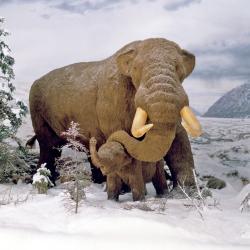Ice Age Extinction
At the end of the last Ice Age in North America, about 12,000 years ago, at least 60 species are known to have gone extinct. For the area that is now New York State, this meant the loss of species such as mammoth, mastodon, stag-moose, giant beaver, and giant ground sloth. The extinction coincided with a significant change in climate as well as the colonization of the continent by humans.
For decades, paleontologists have debated what factors were most likely responsible for this extinction event. Here, we explore four of the most prominently suggested factors and the support for or against their role in the extinction.
Extraterrestrial Impact
FOR: Scientists discovered sediments at some fossil sites that provide evidence for a comet impact approximately 12,900 years ago, right around the time of the Pleistocene Extinction.
AGAINST: The Pleistocene Extinction affected mostly large animals. A comet impact should affect both large and small animals.
At the time of the Ice Age extinction in the region of present-day New York, both tundra and boreal forest habitats were present suggesting the preferred habitats and food of the Ice Age animals were readily available. Therefore, if food and suitable habitats were relatively stable, it is likely that humans played a significant role in the extinction of these species







